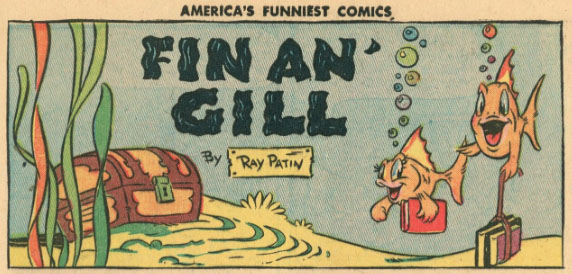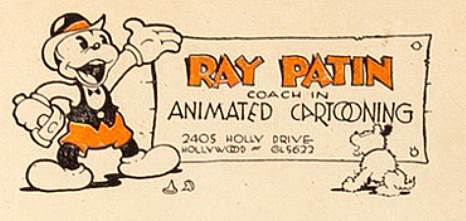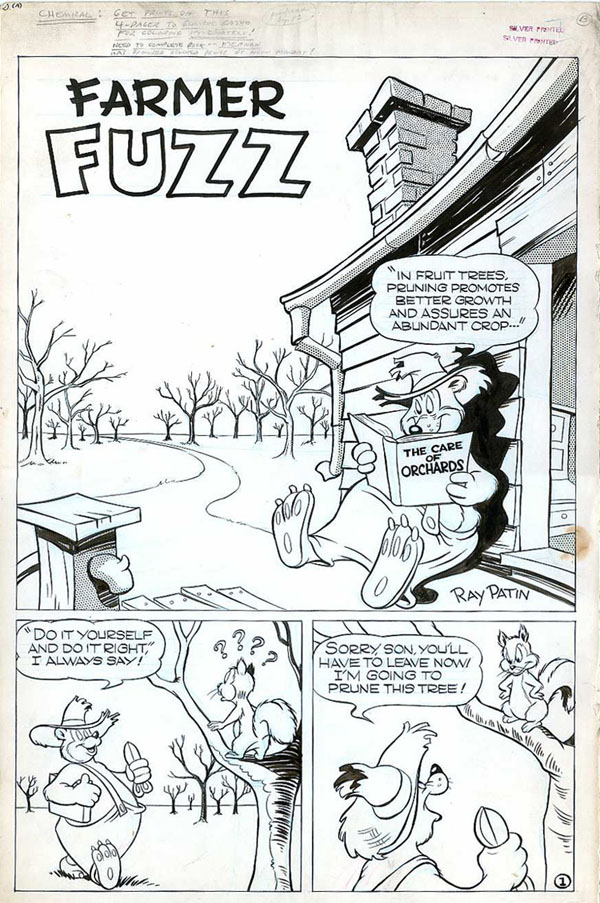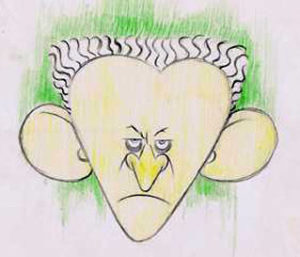
This week’s artist is the animator-turned successful producer of animated commercials, Ray Patin!
Ray Patin was born in 1906 in Beaux Bridge, Louisiana to his mother Therese and his father Maurice. Patin’s father was an experienced newspaper publisher and proprietor who ran several papers including The Lafayette Gazette and Gueydan News. Due to Patin’s uncle Oscar’s wife suffering from tuberculosis, the two moved to Albuquerque, New Mexico for its climate. By 1916, they convinced Patin and his parents to move with them. After Oscar’s wife passed away, he moved to California and persuaded Patin’s family to relocate once again by 1919. In the mid-1920s, Patin seemed to follow his father’s newspaper background, as he drew several illustrations in The Junior Times supplement for The Los Angeles Sunday Times.

Starting in the early 1930s, he worked in animation for Charles Mintz, Ub Iwerks and Harman-Ising. While he worked as an in-betweener and assistant animator in these studios, Patin conducted his own animation course, teaching artists the principles of animation. Supposedly, he continued as an instructor up to the end of the 1930s, when he presented Ub Iwerks as a guest speaker, after Iwerks’ independent ventures as a producer ended. (Hank Ketcham, creator of the American Dennis the Menace comic strip, conducted similar classes as a young in-betweener at Walter Lantz.)

In 1937, Patin joined the Disney studio as an animator; among the titles he animated for Disney was the 1939 Donald Duck cartoon, The Autograph Hound, where he is credited on a few scenes of Donald with Shirley Temple. In 1941, Patin was among the artists that joined the picket line during the studio’s strike, and above all, documented the events with his home movie camera. After he was laid off from Disney, he moved to Warner Brothers. He was never credited for his animation there; an artist whose one scene is credited as “Ray” in the animation draft for Bob McKimson’s Daffy Doodles might be him. Patin volunteered to participate in animated government films made after hours while he held his regular job at Warners. He worked on Point Rationing of Foods (1943) and Hell-Bent for Election (1944), the latter produced by the newly formed UPA.
After he left Warners in November 1944, Patin freelanced in comic book work at James Davis’ shop and served as an animator at the Carey-Weston studio. During this time, in 1945, Patin served as the president of the Screen Cartoonists’ Guild #852, and became the vice president the following year. He returned to Disney for a brief stint in 1946 as an animator and story artist, before he formed his own production company around November 1947. Ray Patin Productions, specialized in commercials and industrial films. Around 1950, he also formed a studio with UPA artist Ted Parmelee, but it is unclear how long it lasted.
Established in Burbank, Ray Patin Productions became one of the successful television commercial houses in the 1950s. Around November 1952, his business became a division of Kling Film Productions, an industrial film company which produced promotional films, educational films, and intermission snipes for theatrical use. His clients in the 1950s included, but wasn’t limited to, Bardahl Top Oil, 7-Up, Jello, Kellogg’s and Rainier Beer.
In August 1955, Patin served as an interim president of Commercial Film Producers Association, which negotiated with the Screen Cartoonists Guild, focusing on “other group representation and location-training of talent.” As a result, a large majority of the other major animated commercial houses (including Cascade, Paul Fennell, Playhouse Pictures, Shamus Culhane Productions, Storyboard Inc., among others) joined the organization.

By the early 1960s, Ray Patin Productions moved from Sunset Blvd. to Cahuenga Blvd., and continued to produce animated commercials. Though it’s not known for certain, it could be assumed he closed up shop during that decade and ventured on his own with the company at his home in Burbank as a lucrative commercial producer. He passed away in 1976 in Los Angeles at the age of 69.
Here’s a sample of Patin’s comic book work, all from James Davis’ shop in the 1940s.
 • “Fin an’ Gill”—America’s Funniest Comics #2 (undated, 1944)
• “Fin an’ Gill”—America’s Funniest Comics #2 (undated, 1944)
• “Si Klops”—America’s Funniest Comics #2 (undated, 1944)
• “Fearless Farmsworth Tries a Little Monkey Business”—Barnyard Comics #6 (September 1945)
• “Wiley Foxxe”—Goofy Comics #12 (February 1946)
• “Wiley Foxxe and Willie Wurtle”—Goofy Comics #13 (April 1946)
• “Painter Pig”—Happy Comics #15 (September 1946)
• “Willie Wurtle”—Barnyard Comics #13 (August 1947)
• “The Whiz Horse”—Merry Go-Round Comics #2 (April-June 1948)
• “Fearless Farnsworth”—Coo Coo Comics #42 (November 1948)

(Thanks to Jerry Beck, Michael Barrier and Yowp for their help.)



 DEVON BAXTER is a film restoration artist, video editor, and animation researcher/writer currently residing in Pennsylvania. He also hosts a
DEVON BAXTER is a film restoration artist, video editor, and animation researcher/writer currently residing in Pennsylvania. He also hosts a 





















































































Again this wonderful series reminds us that many fine cartoonists have been (almost) lost to comics history.
Ray Patin could be the first Louisiana-born animator. (I, too, am a Louisiana native.)
LaVerne Harding and George Grandpre were also born in Louisiana.
Baxter does it again!
This is the best bio of my father, Ray Patin, that I have read. Great facts. All accurate. Well written.
The only wonder I have is the Tee Hee caricature since my father went bald very young and doesn’t have any of those facial features. But, it’s the eye of the beholder. I have not seen a copy of this in my father’s extensive archives.
BTW I have published a memoir about growing up with an animator father. It’s called “In the Shadow of the Sign” and is heavily illustrated with vintage photos, stills from home movies and cartoons. It’ll be published by Theme Park Press this year.
I remember your great grandmother and your grandmother,my Aunt Therese and cousin Vinny. they visited in Louisiana and they were such a delight. my grandmother ,Evelyn Durand, was the sister of Therese. I enjoyed reading about your father…I had heard stories about him working for Disney but didn’t know the extent of his career and talent! my mother was Marjorie, and my sister , Ellie, visited your family in Ca in the 1950’s. anyway, just a quick note to a distant cuz….Judy Fuselier Kozma
My grandfather, Lawrence Durand Bonin (his mother was Blanche Durand from St. Martinville, Louisiana) left his photograph album to me. I have a picture of your Dad in his early teens drawing. My great aunt, Blanchette Bonin Bienvenue related the story to me of the move west because of the tuberculosis his aunt had.
Have there been any books on your Dad?
Thank you,
H. Paul Katner
Sorry, I didn’t see the end of your reply. I’ll try to get your book!
Thank you
Paul
Hello Renee !
You don’t know me , but your Dad was a good friend to my Dad , Jack Buehre ……..
A bit of explanation is in order…….
My Father owned & operated an Animation Camera Service in Hollywood ,
By The name of : ‘ ANICAM ‘, which used to be on 6331 Homewood Avenue,
in Hollywood , right around the Corner from The Hollywood Palace………
Finding out about your Dad today was a blessing ……
I have been looking all over for this information !
Well , long story short : Your Father gave My Dad a Panel Painting , which we had hanging up in our Living room , forever , but this was a long , long, time ago ……My Parents have long since past away , and I have no idea where that Painting went !
My Dad’s business was sold ,along with Our House , and this was way way back in 1973/1974 ……
I am trying to put together my own Blog on all of this stuff and it ain’t easy !
any help is always appreciated ……….
much Love,
Marc Buehre
mrmab2020@gmail.com
p.s. I LOVE Your Dad’s Artwork !